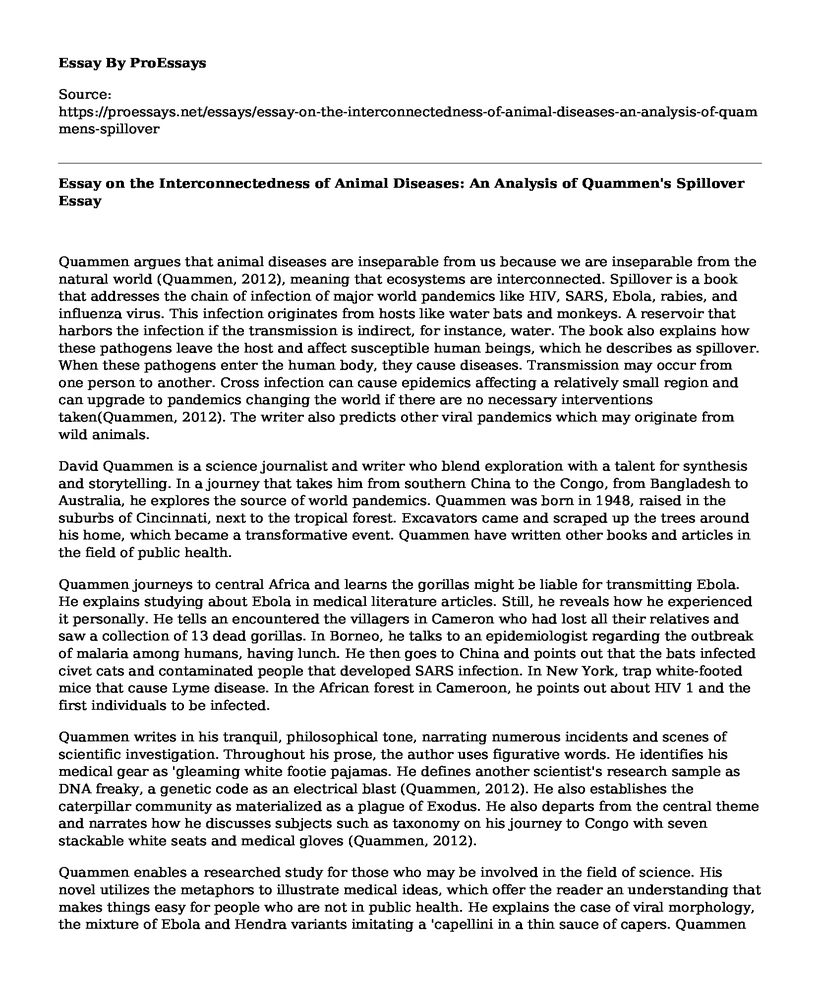Quammen argues that animal diseases are inseparable from us because we are inseparable from the natural world (Quammen, 2012), meaning that ecosystems are interconnected. Spillover is a book that addresses the chain of infection of major world pandemics like HIV, SARS, Ebola, rabies, and influenza virus. This infection originates from hosts like water bats and monkeys. A reservoir that harbors the infection if the transmission is indirect, for instance, water. The book also explains how these pathogens leave the host and affect susceptible human beings, which he describes as spillover. When these pathogens enter the human body, they cause diseases. Transmission may occur from one person to another. Cross infection can cause epidemics affecting a relatively small region and can upgrade to pandemics changing the world if there are no necessary interventions taken(Quammen, 2012). The writer also predicts other viral pandemics which may originate from wild animals.
David Quammen is a science journalist and writer who blend exploration with a talent for synthesis and storytelling. In a journey that takes him from southern China to the Congo, from Bangladesh to Australia, he explores the source of world pandemics. Quammen was born in 1948, raised in the suburbs of Cincinnati, next to the tropical forest. Excavators came and scraped up the trees around his home, which became a transformative event. Quammen have written other books and articles in the field of public health.
Quammen journeys to central Africa and learns the gorillas might be liable for transmitting Ebola. He explains studying about Ebola in medical literature articles. Still, he reveals how he experienced it personally. He tells an encountered the villagers in Cameron who had lost all their relatives and saw a collection of 13 dead gorillas. In Borneo, he talks to an epidemiologist regarding the outbreak of malaria among humans, having lunch. He then goes to China and points out that the bats infected civet cats and contaminated people that developed SARS infection. In New York, trap white-footed mice that cause Lyme disease. In the African forest in Cameroon, he points out about HIV 1 and the first individuals to be infected.
Quammen writes in his tranquil, philosophical tone, narrating numerous incidents and scenes of scientific investigation. Throughout his prose, the author uses figurative words. He identifies his medical gear as 'gleaming white footie pajamas. He defines another scientist's research sample as DNA freaky, a genetic code as an electrical blast (Quammen, 2012). He also establishes the caterpillar community as materialized as a plague of Exodus. He also departs from the central theme and narrates how he discusses subjects such as taxonomy on his journey to Congo with seven stackable white seats and medical gloves (Quammen, 2012).
Quammen enables a researched study for those who may be involved in the field of science. His novel utilizes the metaphors to illustrate medical ideas, which offer the reader an understanding that makes things easy for people who are not in public health. He explains the case of viral morphology, the mixture of Ebola and Hendra variants imitating a 'capellini in a thin sauce of capers. Quammen compares the combination of various antibodies and their viruses to the spraying of holy water on a witch. As far as airborne contamination is involved, he states that the viruses can wave to a nearby village as quickly as the warm, autumnal smell of smoke from a pile of leaves. In his book, the concepts of human and animal infections are the strands of a braided rope (Quammen, 2012).
Quammen is quick to differentiate between facts, assumptions, and perceptions when it comes to these compelling tales. The reader is never left unable to discern the education conclusions. He is flexible with science as he describes spillover, the moment that a pathogen travels from one organism to another. He has a high capacity to illustrate fundamental scientific concepts through funny examples; for example, screening for antibodies is different from insulating viruses, just like a fingerprint is different from a shoe (Quammen, 2012).
Conclusion
In my own opinion, the book is a mystery that is ideal for those searching for knowledge in the sense of the biogeography, the genesis of pathogenic outbreaks and significant world pandemics. According to me, Spillover is a fantastic book for those in the area and public health since it discusses the theory behind these zoonotic diseases and even forecasts future outbreaks that might arise from this pandemic. I know less about scientific exploration to trace the origins of the disease. For instance, AIDS, Quammen explains, is an old illness initiated by a bloody interaction between one chimpanzee and one human in southeastern Cameroon about 1908. I find the novel fun and scary, which makes it fascinating to read, and I would recommend it for anyone interested in the genesis of mysterious pandemics.
Cite this page
Essay on the Interconnectedness of Animal Diseases: An Analysis of Quammen's Spillover. (2023, May 08). Retrieved from https://proessays.net/essays/essay-on-the-interconnectedness-of-animal-diseases-an-analysis-of-quammens-spillover
If you are the original author of this essay and no longer wish to have it published on the ProEssays website, please click below to request its removal:
- Essay Sample on Animal Biotechnologist
- Organic Food vs. Genetically Modified Food
- Essay Sample on Animals Feeding Patterns
- Animals Subjected to Pain: Testing & Experimentation Must Be Banned - Essay Sample
- Otters: Endangered Carnivorous Semiaquatic Mammals - Research Paper
- Paper Example on Sharks & Teleosts: Similarities & Differences
- Why Protect Endangered Species - Free Report Example







